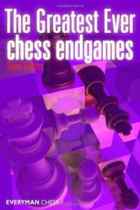Greatest Ever Chess Endgames, The
Steve Giddins

Chess players that buy books like Dvoretskys Engame Manual are filled with the best of intentions. No one will ever argue the ambitious student that works their way through this masterpiece isnt going to improve. But how many people actually read past the first few chapters? The reality is many chess players bookshelves are lined with endgame books that have never been read.
The causes for this phenomena are many and varied. Many amateur players are convinced that all that stands between them and jumping a few rating classes is an improved opening repertoire witness the huge number of monographs on the subject. Another contributor to endgame illiteracy is the lack of readability of many works devoted to the final phase of the game. Finally many of them offer too much information that is too complicated for the majority of readers.
Endgame mastery consists of two parts: knowing a few fundamental positions and being able to play general positions well. Fide Master Steve Giddins new book, The Greatest Ever Chess Endgames, will go a long way to developing the latter qualities.
This entertaining and well-written book consists of 50 famous endgames played between 1893 and 2007. The material is organized around seven chapters:
* Pawn Endings
* Knight Endings
* Bishop Endings
* Bishop v Knight Endings
* Rook Endings
* Queen Endings
* Rook & Minor Piece Endings
Chess players of a certain age will recognize many of the examples which include Fischers famous R+B vs. R+N ending against Taimanov from their 1971 Candidates match and Karpovs win over Kasparov with good knight versus bad bishop (47.Ng2!!). The great Akiva Rubinstein is well represented with five of his best endgames featured. Botvinniks famous win in a Q+P versus Q ending against a young Nikolay Minev at Amsterdam 1954 is also featured, years before Minev would become the heart and soul of Chess Informants Endgame Encyclopedia series and the author of a book on rook endgames highly praised by Garry Kasparov. Despite these examples being well known Giddins has found much that is new to say about them, particularly Capablanca – Tartakover, New York 1924, the rook ending which has been the subject of much discussion in the Russian chess press the past decade.
While almost all the games selected have been played by World Champions and other famous grandmasters a few exceptions are too be found that prove that sometimes good players can play like geniuses. That is certainly the case in the games Torre – Jakobsen, Amsterdam 1973, and Alatortsev – Chekhover, Tbilisi 1937 which hold their ground in comparison with the other games to be found in this book. One cannot help feeling a bit sad realizing that such works of art (and Timman – Velimirovic, Rio de Janiero 1979) are unlikely to be seen in the future due to modern time controls and the lack of adjournments.
Giddins has written an entertaining and instructive book that should find a wide audience from club players right up to 2400.
